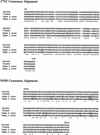Clinical evaluation of two methods for genotyping hepatitis C virus based on analysis of the 5' noncoding region
- PMID: 12682145
- PMCID: PMC153875
- DOI: 10.1128/JCM.41.4.1558-1564.2003
Clinical evaluation of two methods for genotyping hepatitis C virus based on analysis of the 5' noncoding region
Abstract
We compared the performance characteristics of a standardized direct sequencing method (TRUGENE HCV 5'NC; Visible Genetics Inc., Toronto, Ontario, Canada) and a reverse hybridization line probe assay (INNO-LiPA HCV II; Bayer Corp., Tarrytown, N.Y.) for genotyping of hepatitis C virus (HCV). Both methods are based on detection of sequence heterogeneity in the 5' noncoding (5'NC) region. Concordance between the genotyping methods was assessed by testing 172 samples representing the six major genotypes. Sequence analysis of the more phylogenetically informative nonstructural 5B (NS5B) region was also done with 148 (86%) samples to confirm the accuracy of and resolve discrepancies between the 5'NC genotyping results. The sensitivities of the methods were assessed by using the 5'NC amplicon from both the qualitative and quantitative AMPLICOR HCV tests (Roche Diagnostics Corp., Indianapolis, Ind.). The ability of the methods to detect mixed-genotype infections was determined with mixtures of two different genotypes at relative concentrations ranging from 1 to 50%. Both 5'NC methods were able to genotype 99.4% of the samples with type agreement for 99.5% and subtype agreement for 68.2% of the samples. No or ambiguous subtype results were found by the line probe assay for 16.5% and by the TRUGENE 5'NC test for 17.1% of the samples. Discrepancies occurred between the line probe assay and NS5B results at the type level for 1.4% of the samples and at the subtype level for 14.2% of the samples. Discrepancies also occurred between the TRUGENE 5'NC and NS5B results at the type level for 2% of the samples and at the subtype level for 8.1% of the samples. We also found two distinct strains of HCV classified as type 2 by analysis of the 5'NC region that were type 1 by analysis of the NS5B region. The sensitivities of the two 5'NC genotyping methods were comparable and dependent on the amplification test used ( approximately 10(3) IU/ml with the qualitative HCV RNA tests and approximately 10(5) IU/ml with the quantitative HCV RNA tests). Genotype mixtures were successfully identified at a relative concentration of 5% by the line probe assay and 10% by the TRUGENE 5'NC test. In conclusion, the performance characteristics of the 5'NC methods were similar and both methods produced accurate results at the genotype level but neither method should be used for subtyping.
Figures

Similar articles
-
Evaluation of the TRUGENE HCV 5'NC genotyping kit with the new GeneLibrarian module 3.1.2 for genotyping of hepatitis C virus from clinical specimens.J Clin Microbiol. 2003 Oct;41(10):4855-7. doi: 10.1128/JCM.41.10.4855-4857.2003. J Clin Microbiol. 2003. PMID: 14532242 Free PMC article.
-
Evaluation of a new assay in comparison with reverse hybridization and sequencing methods for hepatitis C virus genotyping targeting both 5' noncoding and nonstructural 5b genomic regions.J Clin Microbiol. 2008 Jan;46(1):192-7. doi: 10.1128/JCM.01623-07. Epub 2007 Nov 7. J Clin Microbiol. 2008. PMID: 17989191 Free PMC article.
-
Direct comparison of hepatitis C virus genotypes tested by INNO-LiPA HCV II and TRUGENE HCV genotyping methods.J Clin Virol. 2003 Oct;28(2):214-6. doi: 10.1016/s1386-6532(03)00076-3. J Clin Virol. 2003. PMID: 12957191
-
Genotyping of hepatitis C virus-comparison of three assays.J Clin Virol. 2003 Aug;27(3):276-85. doi: 10.1016/s1386-6532(02)00183-x. J Clin Virol. 2003. PMID: 12878092
-
Genotyping of hepatitis C virus isolates using CLIP sequencing.J Clin Microbiol. 2000 Oct;38(10):3581-4. doi: 10.1128/JCM.38.10.3581-3584.2000. J Clin Microbiol. 2000. PMID: 11015367 Free PMC article.
Cited by
-
Evaluation of the TRUGENE HCV 5'NC genotyping kit with the new GeneLibrarian module 3.1.2 for genotyping of hepatitis C virus from clinical specimens.J Clin Microbiol. 2003 Oct;41(10):4855-7. doi: 10.1128/JCM.41.10.4855-4857.2003. J Clin Microbiol. 2003. PMID: 14532242 Free PMC article.
-
Evaluation of Versant hepatitis C virus genotype assay (LiPA) 2.0.J Clin Microbiol. 2008 Jun;46(6):1901-6. doi: 10.1128/JCM.02390-07. Epub 2008 Apr 9. J Clin Microbiol. 2008. PMID: 18400913 Free PMC article.
-
Hepatitis B and C virus infections among patients with end stage renal disease in a low-resourced hemodialysis center in Vietnam: a cross-sectional study.BMC Public Health. 2015 Feb 27;15:192. doi: 10.1186/s12889-015-1532-9. BMC Public Health. 2015. PMID: 25886623 Free PMC article.
-
Use of sequence analysis of the NS5B region for routine genotyping of hepatitis C virus with reference to C/E1 and 5' untranslated region sequences.J Clin Microbiol. 2007 Apr;45(4):1102-12. doi: 10.1128/JCM.02366-06. Epub 2007 Feb 7. J Clin Microbiol. 2007. PMID: 17287328 Free PMC article.
-
Controversies in and challenges to our understanding of hepatitis C.World J Gastroenterol. 2007 Aug 21;13(31):4168-76. doi: 10.3748/wjg.v13.i31.4168. World J Gastroenterol. 2007. PMID: 17696244 Free PMC article. Review.
References
-
- American Medical Association. 2001. Current procedural terminology 2002. American Medical Association, Chicago, Ill.
-
- Ansaldi, F., F. Torre, B. M. Bruzzone, A. Picciotto, P. Crovari, and G. Icardi. 2001. Evaluation of a new hepatitis C virus sequencing assay as a routine method for genotyping. J. Med. Virol. 63:17-21. - PubMed
Publication types
MeSH terms
Substances
LinkOut - more resources
Full Text Sources
Other Literature Sources

